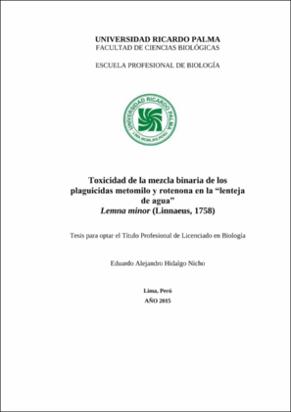| dc.contributor.author | Hidalgo Nicho, Eduardo Alejandro | |
| dc.date.accessioned | 2016-08-10T20:21:38Z | |
| dc.date.available | 2016-08-10T20:21:38Z | |
| dc.date.issued | 2015 | |
| dc.identifier.uri | https://hdl.handle.net/20.500.14138/698 | |
| dc.description.abstract | Se evaluó la toxicidad individual y binaria de los plaguicidas metomilo y rotenona en la macrofita Lemna minor (Linnaeus, 1753) para determinar la acción sinérgica o antagónica de una mezcla equitóxica. Los ensayos se realizaron bajo condiciones de laboratorio (T 29 ± 2°C; H 48,6 ± 9,4 %) y los resultados fueron analizados con los programas estadísticos BMDS® y Probit para calcular la concentración efectiva media (CE50) a través de los parámetros Área de la Fronda (AF) y Nuevas Frondas (NF). Los resultados sugieren una mayor precisión al utilizar el Método del Punto de Referencia del programa BMDS® para el cálculo de la concentración efectiva. Adicionalmente, se calculó la concentración total de clorofila (CTC) y peso húmedo (PH) para determinar la inhibición del crecimiento (Ir). Del mismo modo, se realizó una comparación entre los valores NOAEL (nivel de efecto no observado) y LOAEL (nivel bajo de efecto observado) versus los valores de BMDL (límite inferior del punto de referencia) y BMD (nivel de variación en el punto de referencia), respectivamente. El análisis muestra que existe una mayor precisión al emplear los valores BMD y BMDL. La acción fitotóxica varió según el parámetro analizado. La CE50 mostró mayores valores en el parámetro NF (1079,22 mg·L-1 para rotenona; 7147,42 mg·L-1 para metomilo; 597,904 mg·L-1 mezcla binaria: metomilo y 298,93 mg·L-1 mezcla binaria: rotenona) que en el parámetro AF (782,173 mg·L-1 para rotenona; 6919,79 mg·L-1 para metomilo; 629,513 mg·L-1 mezcla binaria: metomilo y 314,754 mg·L-1 mezcla binaria: rotenona). Finalmente, el modelo de concentración-adición mostró que la acción fitotóxica de la mezcla de ambos plaguicidas en Lemna minor tiene un efecto sinérgico.
Macrophyte Lemna minor (Linnaeus, 1753) was used to evaluate the phytotoxicity of the individual and mix action of methomyl and rotenone pesticides under laboratory conditions (Temperature 29 ± 2°C; Humidity 48,6 9,4 %). The taken measures to establish half effective concentration (EC50) were the frond area (AF) and production of new fronds (NF). In this study, BMDS® and Probit stadistical data analyses were used to compare the results about effective concentration. Results suggest Benchmark dose method of BMDS® program was more effective than Probit program when EC50 were determined. Additionally, total chlorophyll concentration (CTC) and humidity weight (PH) parameters were calculated to determinate the growth inhibition (Ir). Likewise, NOAEL (no observed adverse effect level) and LOAEL (low observer adverse effect level) were compared with BMDL (lower bench mark dose) and BMD (Bench mark dose), respectively. BMD and BMDL values were more accurate than NOAEL and LOAEL values. Phytotoxic action varied according the parameter. EC50 values of Lemna minor showed poor sensibility to methomyl pesticide with an elevated concentration in both parameters (6919,79 mg•L-1 and 7147,42 mg•L-1 for AF and NF, respectively). Results of rotenone pesticide were lower than methomyl, with 1079,22 mg•L-1 (NF) and 782,173 mg•L-1 (AF). Finally, the mix toxicity was 597,904 mg•L-1 (methomyl: NF), 298,93 mg•L-1 (rotenone: NF), 629,513 mg•L-1 (methomyl: AF) and 314,754 mg•L-1 (rotenone: AF). For synergy calculation, Concentration-Adition value was used, concluding a higher synergism. | es_ES |
| dc.description.sponsorship | Submitted by Wong Rafael (rafel_wl@hotmail.com) on 2016-08-10T20:21:38Z
No. of bitstreams: 1
hidalgo_ea.pdf: 2026077 bytes, checksum: 4cfc9920a4aefbd6cfc020c3a7ada8d5 (MD5) | es_ES |
| dc.description.sponsorship | Made available in DSpace on 2016-08-10T20:21:38Z (GMT). No. of bitstreams: 1
hidalgo_ea.pdf: 2026077 bytes, checksum: 4cfc9920a4aefbd6cfc020c3a7ada8d5 (MD5)
Previous issue date: 2015 | es_ES |
| dc.description.sponsorship | Restored into DSpace on 2016-12-07T20:39:32Z (GMT). | es_ES |
| dc.description.uri | Tesis | es_ES |
| dc.format | application/pdf | |
| dc.language.iso | spa | |
| dc.publisher | Universidad Ricardo Palma - URP | es_ES |
| dc.rights | info:eu-repo/semantics/openAccess | |
| dc.rights.uri | https://creativecommons.org/licenses/by-nc-nd/4.0/ | |
| dc.source | Repositorio Institucional - URP | es_ES |
| dc.subject | BMD | es_ES |
| dc.subject | BMDL | es_ES |
| dc.subject | CE50 | es_ES |
| dc.subject | Lemna minor | es_ES |
| dc.subject | metomilo | es_ES |
| dc.subject | rotenona | es_ES |
| dc.subject | toxicidad binaria | es_ES |
| dc.subject | toxicidad individual | es_ES |
| dc.subject | Binary toxicity | es_ES |
| dc.subject | BMD | es_ES |
| dc.subject | BMDL | es_ES |
| dc.subject | individual toxicity | es_ES |
| dc.subject | Lemna minor | es_ES |
| dc.subject | methomyl | es_ES |
| dc.subject | rotenone | es_ES |
| dc.title | Toxicidad de la mezcla binaria de los plaguicidas metomilo y rotenona en la “lenteja de agua” Lemna minor (Linnaeus, 1758) | es_ES |
| dc.type | info:eu-repo/semantics/bachelorThesis | |
| thesis.degree.discipline | Biología | es_ES |
| thesis.degree.grantor | Universidad Ricardo Palma. Facultad de Ciencias Biológicas. Escuela Profesional de Biología | es_ES |
| thesis.degree.level | Título Profesional | es_ES |
| thesis.degree.name | Licenciado en Biología | es_ES |
| dc.publisher.country | PE | es_ES |
| renati.type | https://purl.org/pe-repo/renati/type#tesis | |
| renati.level | https://purl.org/pe-repo/renati/nivel#tituloProfesional | |
| renati.discipline | 511206 | |
| dc.type.version | info:eu-repo/semantics/publishedVersion | |


